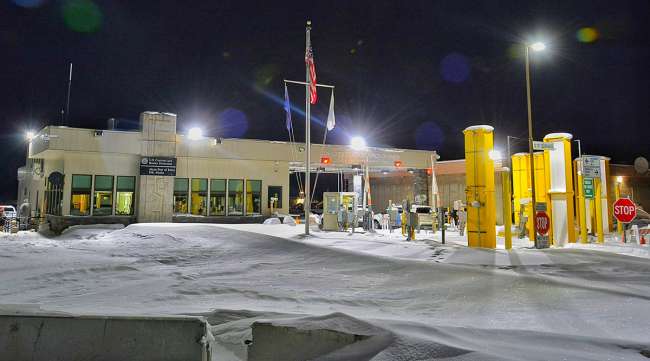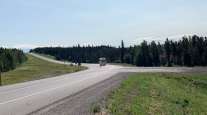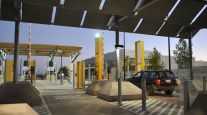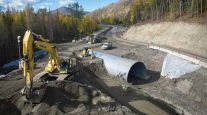Staff Reporter
GSA to Overhaul Remote Alaskan Border Facility

[Stay on top of transportation news: Get TTNews in your inbox.]
The U.S. General Services Administration is eyeing how best to rebuild its aging Alcan land entry port along a remote Alaskan freight route where truckers and border officers must stand outside to exchange documents in temperatures that often plunge 50 degrees below zero.
Aaron Evanson, GSA project manager, explained that the plan is to entirely reconstruct the key border crossing facility built in 1972 near Tok, Alaska, since it is in poor condition for GSA staff and U.S. Customs and Border Protection officers.
The modernization project is expected to cost from $170 million to $190 million. GSA in August awarded a $2.5 million contract for a project development study to modernize and expand the Alcan port. The new port is scheduled for completion in 2029.
Upgrades also will be made for the infrastructure to better handle commercial vehicles and deploy advanced technology at the site.
Currently commercial trucks must use a third uncovered lane (40 feet from the main building) since it is the only lane with high enough clearance. To access this third lane, truckers must maneuver their vehicles through a tight “S” turn. This configuration means CBP officers have to leave the main port building and walk outdoors to the commercial processing lane no matter how bad the weather is.

Evanson
“The commercial traffic has to go through the radiation portals outside of the canopy. So when it’s negative 50 degrees outside, which it often is, the officers have to get out and the truckers have to get out to transfer information and paperwork. It’s dangerous to be perfectly honest,” Evanson said.
GSA is planning to install higher canopies so truckers can drive through the first lane next to the port building and pass over documents without leaving their vehicles. “There’s going to be what’s called a high-low booth inside the port building itself. The inspectors or officers can access lower levels to hand paperwork and passports directly through the window with ease to regular cars and trucks. Then there’s an elevated platform inside the building to use to access the big rigs. The big rigs can come directly up to the window and officers will access that higher window to pass paperwork directly back and forth,” Evanson noted.
Technological upgrades are planned, especially for automated nonintrusive inspections of commercial vehicles typical in other border crossings. In Alcan, CBP officers use handheld radiation scanners and walk around trucks during inspections.
Evanson said, “We’re upgrading a lot of that technology to be automated at that border. We do see more traffic. It is estimated at 2% per year increase annually over next 10 or 15 years in both personally operated vehicles and commercial vehicles. All of that nonintrusive inspection technology will be in that first lane so truckers and officers don’t have to get out in the dead of winter and do all of those handheld inspections, and truckers don’t have to get out to pass over paperwork. It makes the process a lot faster and safer for everyone involved.”
GSA is also exploring heating concrete lanes for commercial vehicles to stop truck exhaust from instantly freezing and dropping to the ground in solid ice. Several times daily, GSA staff must use a tractor with ice scrapers to break the ice, which can rise up to 8 inches high in a speed bump mound, preventing trucks from passing.
The hard ice often breaks the steel scrapers and causes GSA to replace the high-strength concrete lane every few years. The climate is so harsh asphalt can’t be used in the truck lane since its scrapes off with the ice.
“With the truck lane, we are talking about heating the concrete itself directly under the canopies so it just melts off the exhaust flow from trucks,” Evanson said.
GSA and other federal officials are in talks with Canadian government counterparts about collocating in the new Alcan facility in shared non-sensitive space such as offices, a helipad and temporary sleeping quarters for officer use in bad weather. Canadian officials have wanted to move their border crossing facility 20 miles inland in the Yukon territory on First Nations land, but there is a lack of suitable land in the area for construction.
Numerous policy issues are involved for both governments, especially since it would mean Canadian government employees would be operating on foreign soil in Alcan.
Want more news? Listen to today's daily briefing above or go here for more info
“There’s a hope that we can make that work because it would be a very good model for future border stations. There are tons of bonuses in this,” Evanson said. “It would benefit both governments and taxpayers of both [countries] to see how it works.”
In the meantime, GSA is in the project development phase. “One of our major goals is to make it faster and easier to process commercial cargo through the port itself, especially through the winter months [October to July] when it can be a very difficult process,” Evanson said.




